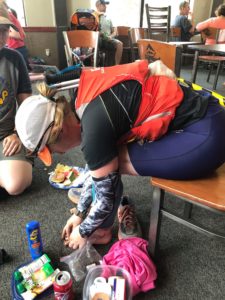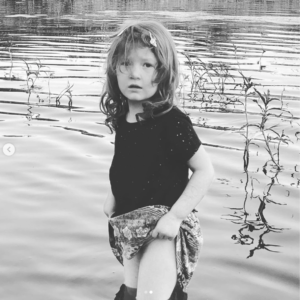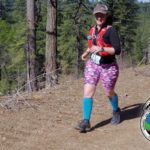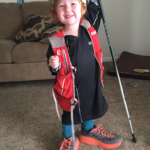The Drop Bag v. 1
| May 30, 2021 | Posted by Melinda under Uncategorized |
Sunday Shorts???? What was I thinking? That was a stupid name, and has been upgraded to the drop bag, which is a far more fitting for the blog that is mostly about endurance stuff.
So, just like last time this is a variety of short topics and going-ons that I want to share. I write each of these little mini topics over a morning cup of coffee. At the end of the week I’ll push “publish” and share the drop bag of mini-posts.
Burning River Training
The race specific training I need for Burning River 100 mile in July is either awful or wonderful. Long hot flat miles with some pavement sounds perfect. Fortunately that’s exactly what I have out my front door. Unfortunately that is not the type of running that gets me out of bed to get the long runs in. Fortunately running at 4pm in the afternoon will get me even MORE heat training! Unfortunately I don’t know anyone else that wants to do 10-60 mile runs with me unless there’s hills, trails, and getting lost in the loads. Fortunately when one runs in town there is the possibility of creating aid stations out of fruit stands, cafes, and mobile ordering. (door dash? Is that a thing if you meet someone at the intersection of that one farm house and peach orchard in 30 minutes).
I’ve been doing these races long enough that BR100 looks exactly like a race that I DNF. Fairly flat, not technical, and a couple time zones away.
I will NOT DNF this race. I know what I need to do to finish it and it doesn’t involve long drives to the mountains. I simply must step outside my front door and run, reminding my body how to run the flats and keep it up.
Buff Arm Sleeves
I’m not sure if I have featured these on a recent “not a gift guide” post, but if I haven’t here is a reminder…I love these arm sleeves!
Two different races a couple years apart.
These arm sleeves are made by buff and over the years they have proved themselves durable, comfortable, and functional. What more could I ask?
I wear them rotated 180 degrees so that the seem lies on the outside of my arm instead of in my armpit. They are big enough to shove ice in, but not feel too squeezy. After three years of regular use, they were starting to show signs of wear, so I picked up another pair in a light color. The women’s choices were limited so I got a pair of men’s and they fit my arms even better than the women’s. Snug enough to stay up on my arms without tugging, but longer and looser fit compared to the woman’s.
If you are a fan of covering up for sun exposure (and I think you should be!) check them out.
Reframing
A picture may be worth a 1000 words, but remember that photos are an edit of real life, just like blogging or any other opinion piece.
The pictures above are screen shots of photos I posted of instagram during a road trip to visit family (my first post pandemic and post vaccine!). Looks peaceful right? Just me and my daughter enjoying the serenity of some river while we take a break from picking blackberries.
Nope.
The reality of those pictures is that it was complete and utter chaos reining around us. A live band with the amps turned up too loud behind us, people screaming and yelling and kids throwing rocks in the water.
She had just finished having a complete crying meltdown on the beach because she couldn’t get into the water where she wanted to. It was the last night of a whirl wind trip to visit some family and this was her breaking point.
But that’s not what you see in these pictures.
I think we all know that how something is edited can influence the way we feel about something – whether a picture or a written piece. Editing something correctly can make a cluttered image focused and powerful. It can also be used to mislead and manipulate.
But, I think there’s another lesson beyond just a cautionary tale about editing and taking things at face value.
The power of reframing.
Reframing is a type of internal mental editing that I think leads to resilience and happiness. It’s seeing the yellow flower on bush in the middle of an empty lot that is littered in trash. It’s choosing to find spot of joy in situations that you can’t change. It’s acknowledging that there is more than one way to look at a situation and they are all versions of the truth….and sometimes you get to pick which version you want to live with. Sometimes reframing means looking at how your story is fitting in to the larger whole, and sometimes it is focusing it down to just your self and blocking everything else out around you.
Reframing is taking a picture in a chaotic moment that wasn’t taken in the perfect moment, but lets you remember all the perfect moments that did happen on the trip when you weren’t carrying the camera.
If you pride yourself on always sticking to the truth and nothing but the truth and feel like reframing is hogwash, a doorway to denial, and absolute crap…here’s the thing. Even if you aren’t consciously reframing events, I guarantee that you are doing in unconsciously. Our minds like tidy stories and our life is a story. Research has shown that we edit our memories in order to make them more cohesive and a better narrative. We want to make sense of life and how we fit into it. We tie up loose ends and twist the narrative just enough jive with previously held beliefs, biases, and other life experiences.
So go ahead. Find the pretty moment in the chaos. Change what you can, let go of what you can’t, and focus on the important things. Find a way to keep moving forward and don’t stop looking for the pretty flowers growing in the trash.
So you wanna run a 100 miler
A couple of months ago some friends asked me to do a Zoom meeting to discuss running a 100 miler. What were my top tricks and strategies? How do you train for and run a 100 miler on a normal person schedule?
I can talk for hours about endurance events….but when I only have 30 minutes, here’s what rose to the top as the most important.
Taper
- It’s not as extreme or regimented as marathon training. Keep the frequency of running the same in the last 14 days, but cut the volume. Don’t do a 100k any closer than 6 weeks. I try not to do anything significantly over 20 miles within 3 weeks of a 100 miler. All the major training has to be done prior to the 4 week mark. The last month you are trying to keep yourself in some sort of rhythm, give your feet a chance to recover from the miles. The last 3 weeks prior to a 100 miler I do some slow easy 2 hour hikes, some focused speed walking around the city block I live on (less than an hour), and a lot of easy 30-60 runs with a few speed sessions mixed in.
Trickle the calories in
- Most people need 200-300 calories per hour. Try to eat every 30 minutes. A significant amount of problems during long ultras are calorie issues. You can experiment with how many calories on what interval, but a good starting point is to try and replace 50% of the calories burned while in the race. Making up calories if you stop eating for a while is really tough. Palate fatigue is real, have several fueling plans and practice them all. I have a total of 3: Normal, bonking, middle of the night.
The importance of small runs
- Your 30-40 minutes “regular” runs are still important!!!! When I look at Rio Del Lago training, a 100 mile race that I’ve run several times, I can easily predict a year I’ll finish and one I won’t just based on how many runs I did between 1-5 miles. The number of long runs and races I do are identical between years I finish rio and years I don’t….The difference is the number of short runs.I don’t exactly know why those shortie runs are important, but for me, they are. Maybe for you they are too.
All the walking
- There’s going to be a ton of walking. Hours of walking. You should probably practicing walking. When you are fresh, when you are tired, when it’s dark outside, when you are crying, when you just ate a big meal…..all these are perfect times to go out for a focused power walk or hike. My advice is to do 30-60 min of power walking a week in 1-2 sessions. Don’t sacrifice your runs to do it…but make some time for the walks.
Don’t run out of water.
- Carry a third bottle if you need. Or a fourth. Or choose a different hydration system for long or short stretches of the course. But the bottom line is…don’t run out of water during a 100 miler. It’s really hard to get hydration, electrolytes, and calories back on track even with just a short blip in water consumption.
Drop bag organization
- Organize it. Make it efficient. Stalk other runners and see what they do. Scour the internet. A light colored bag or container is easier to see items in. A lid that zips or unfastens and flips ALL the way open can be a time saver. You probably will lose your fine motor skills earlier than you anticipate in the race. Make things easy to find, pick up, and open. Put small items in clear containers or pouches with clear windows makes it easier to find everything. Label everything really clearly with sharpie on an index card and tape the card to containers.
Cross training
- Your long runs are king and any cross training can’t take priority over getting the runs in. Lots of ultra runners don’t cross train. But most who have been in the sport for a while do, and I can tell you from personal experience that something as simple as easy but regular yoga sessions have done more for my running than squeezing in one more medium distance run in the month.
Is a marathon harder or easier?
- A 100mi or any other ultra distance isn’t harder than a marathon, it’s just different. The duration of pain is longer in a 100mi. There will be moments where you long for the brutal push in the last 6 miles of the marathon, because anything is preferable to the endless pain cave slog of a 100mi when there’s still 12 miles to go. But, a 100mi is easier because there’s time to problem solve and figure it out. You can change shoes if you have to. Sit down in a chair for 5 minutes. Eat a cup of broth and noodles. Come out on the other side of this bonk stronger than you have felt for the last 20 miles. Time is both the savior and the devil of the 100 mile race and I find 100 miles physical easier but more mentally strenuous than a marathon. You won’t really know until you do one, but don’t assume that because you find a marathon distance or 50k difficult, that running a 100 mile race is out of the question for you.
That’s it for this drop bag. Happy trails!















